1996 CHEVROLET S10 power steering
[x] Cancel search: power steeringPage 139 of 375
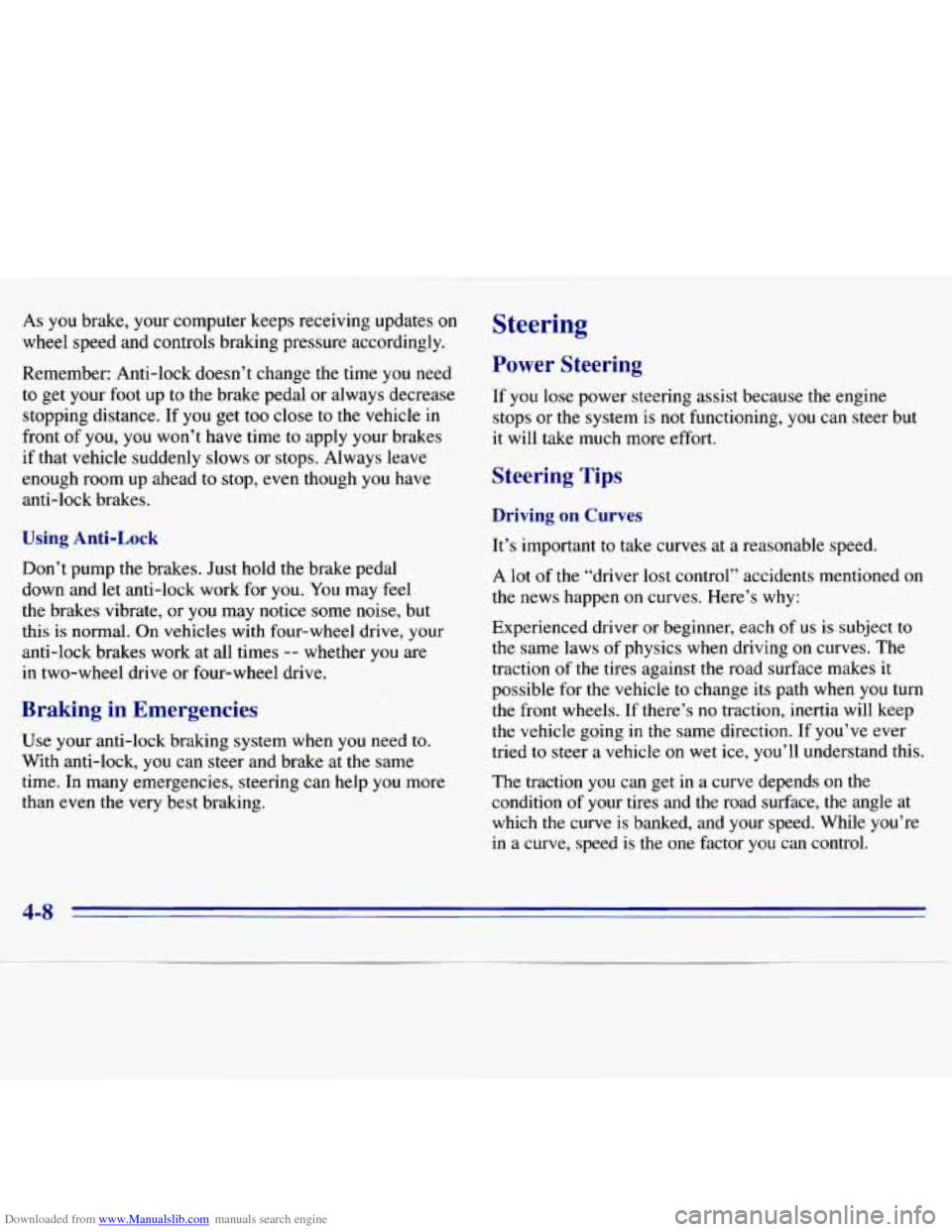
Downloaded from www.Manualslib.com manuals search engine As you brake, your computer keeps receiving updates on
wheel speed and controls braking pressure accordingly.
Remember: Anti-lock doesn’t change the time you need
to get your foot up to the brake pedal or always decrease
stopping distance. If
you get too close to the vehicle in
front of
you, you won’t have time to apply your brakes
if that vehicle suddenly
slows or stops. Always leave
enough room up ahead
to stop, even though you have
anti-lock brakes.
Using Anti-Lock
Don’t pump the brakes. Just hold the brake pedal
down and let anti-lock work for
you. You may feel
the brakes vibrate, or
you may notice some noise, but
this is normal. On vehicles with four-wheel drive, your
anti-lock brakes work at all times
-- whether you are
in two-wheel drive or four-wheel drive.
Braking in Emergencies
Use your anti-lock braking system when you need to.
With anti-lock, you can steer and brake
at the same
time. In many emergencies, steering can help you more
than even the very best braking.
Steering
Power Steering
If you lose power steering assist because the engine
stops or the system is not functioning,
you can steer but
it will take much more effort.
Steering Tips
Driving on Curves
It’s important to take curves at a reasonable speed.
A lot of the “driver lost control” accidents mentioned on
the news happen
on curves. Here’s why:
Experienced driver or beginner, each
of us is subject to
the same laws
of physics when driving on curves. The
traction
of the tires against the road surface makes it
possible for the vehicle to change its path when you turn
the front wheels. If there’s no traction, inertia will keep
the vehicle going
in the same direction. If you’ve ever
tried
to steer a vehicle on wet ice, you’ll understand this.
The traction you can get in a curve depends
on the
condition of your tires and the road surface, the angle at which
the curve is banked, and your speed. While you’re
in a curve, speed is the one factor you can control.
4-8
Page 149 of 375
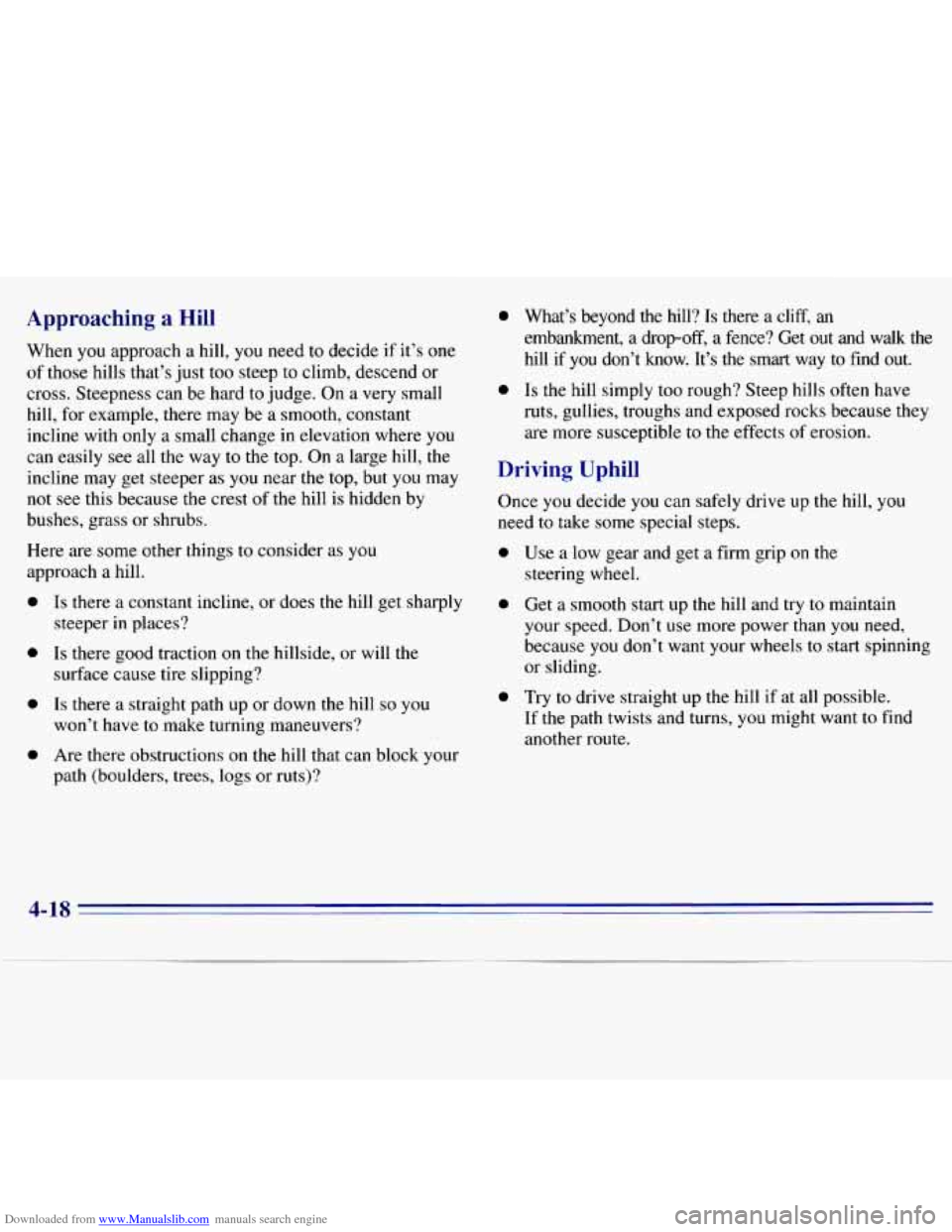
Downloaded from www.Manualslib.com manuals search engine Approaching a Hill
When you approach a hill, you need to decide if it’s one
of those hills that’s just too steep to climb, descend or
cross. Steepness can be hard
to judge. On a very small
hill,
for example, there may be a smooth, constant
incline with
only a small change in elevation where you
can easily see all the way to the top. On a large hill, the
incline may get steeper as
you near the top, but you may
not see this because the crest
of the hill is hidden by
bushes, grass or shrubs.
Here
are some other things to consider as you
approach a hill.
0
0
0
0
Is there a constant incline, or does the hill get sharply
steeper in places?
Is there good traction on the hillside, or will the
surface cause tire slipping?
Is there a straight path up or down the hill so you
won’t have to make turning maneuvers?
Are there obstructions on the hill that can block your
path (boulders, trees, logs or ruts)?
0 What’s beyond the hill? Is there a cliff, an
embankment, a drop-off, a fence? Get out and walk the
hill if
you don’t know. It’s the smart way to find out.
0 Is the hill simply too rough? Steep hills often have
ruts, gullies, troughs and exposed rocks because they
are more susceptible to the effects
of erosion.
Driving Uphill
Once you decide you can safely drive up the hill, you
need
to take some special steps.
0
0
0
Use a low gear and get a firm grip on the
steering wheel.
Get a smooth start up the hill and try to maintain
your speed. Don’t use more power than
you need,
because you don’t want your wheels to start spinning
or sliding.
Try
to drive straight up the hill if at all possible.
If the path twists and turns, you might want to find
another route.
4-18
Page 234 of 375
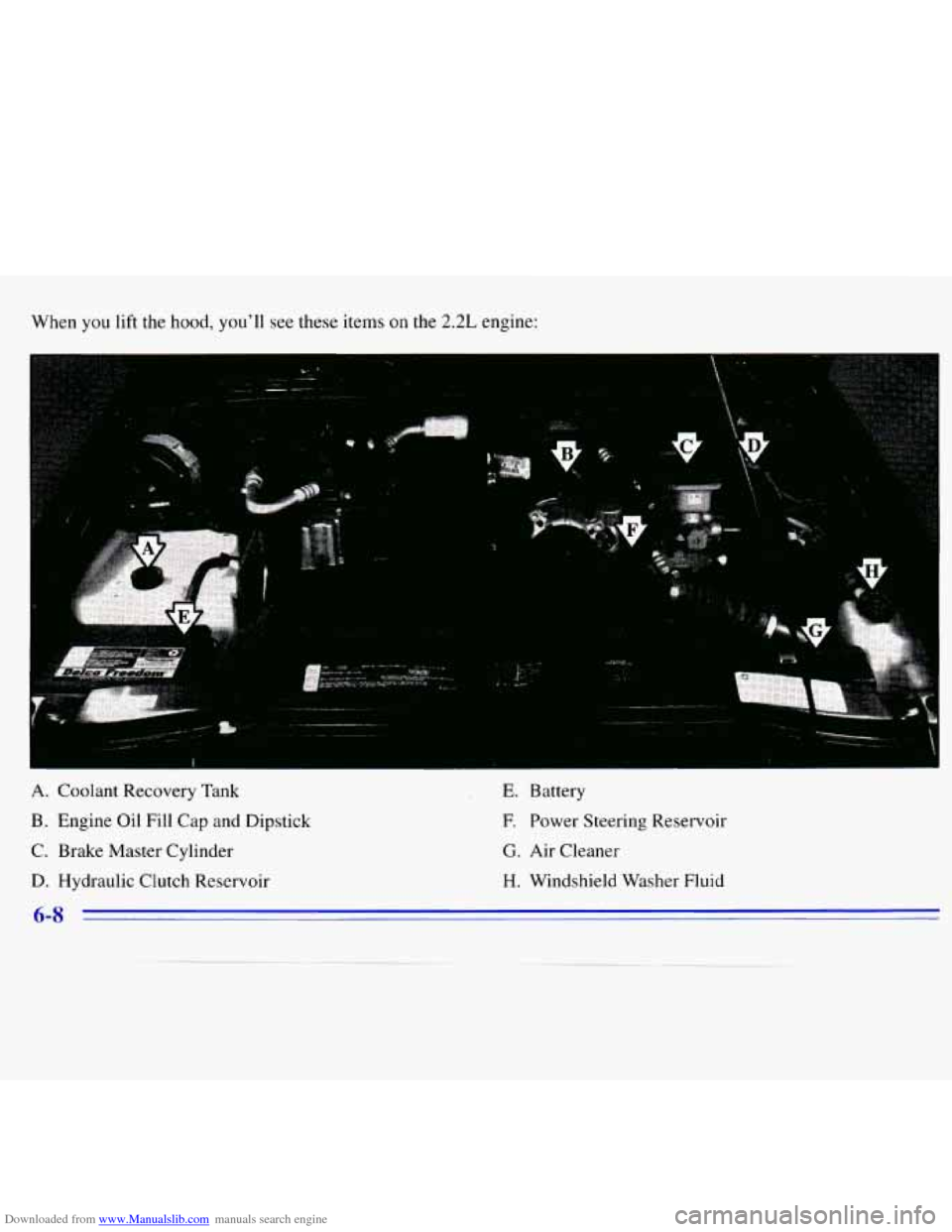
Downloaded from www.Manualslib.com manuals search engine When you lift the hood, you'll see these items on the 2.2L engine:
A. Coolant Recovery Tank
E. Battery
B. Engine Oil Fill Cap and Dipstick E Power Steering Reservoir
C. Brake Master Cylinder G. Air Cleaner
D. Hydraulic Clutch Reservoir H. Windshield Washer Fluid
6-8
Page 235 of 375
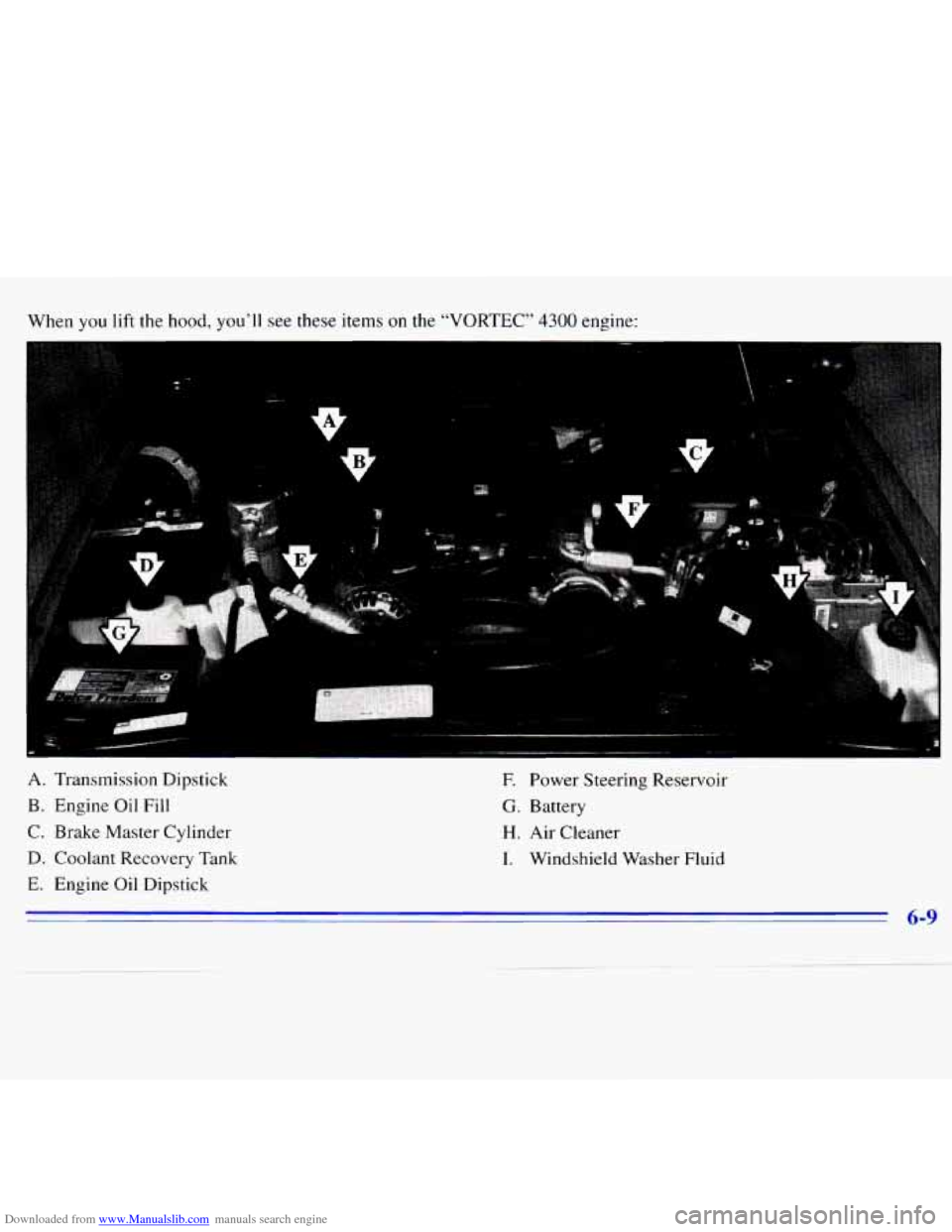
Downloaded from www.Manualslib.com manuals search engine When you lift the hood, you’ll see these items on the “VORTEC” 4300 engine:
V
I. Transmission Dipstick
3. Engine Oil Fill
2. Brake Master Cylinder
1. Coolant Recovery Tank
:. Engine Oil Dipstick
6-9
E Power Steering Reservoir
G. Battery
H. Air Cleaner
I. Windshield Washer Fluid
Page 255 of 375
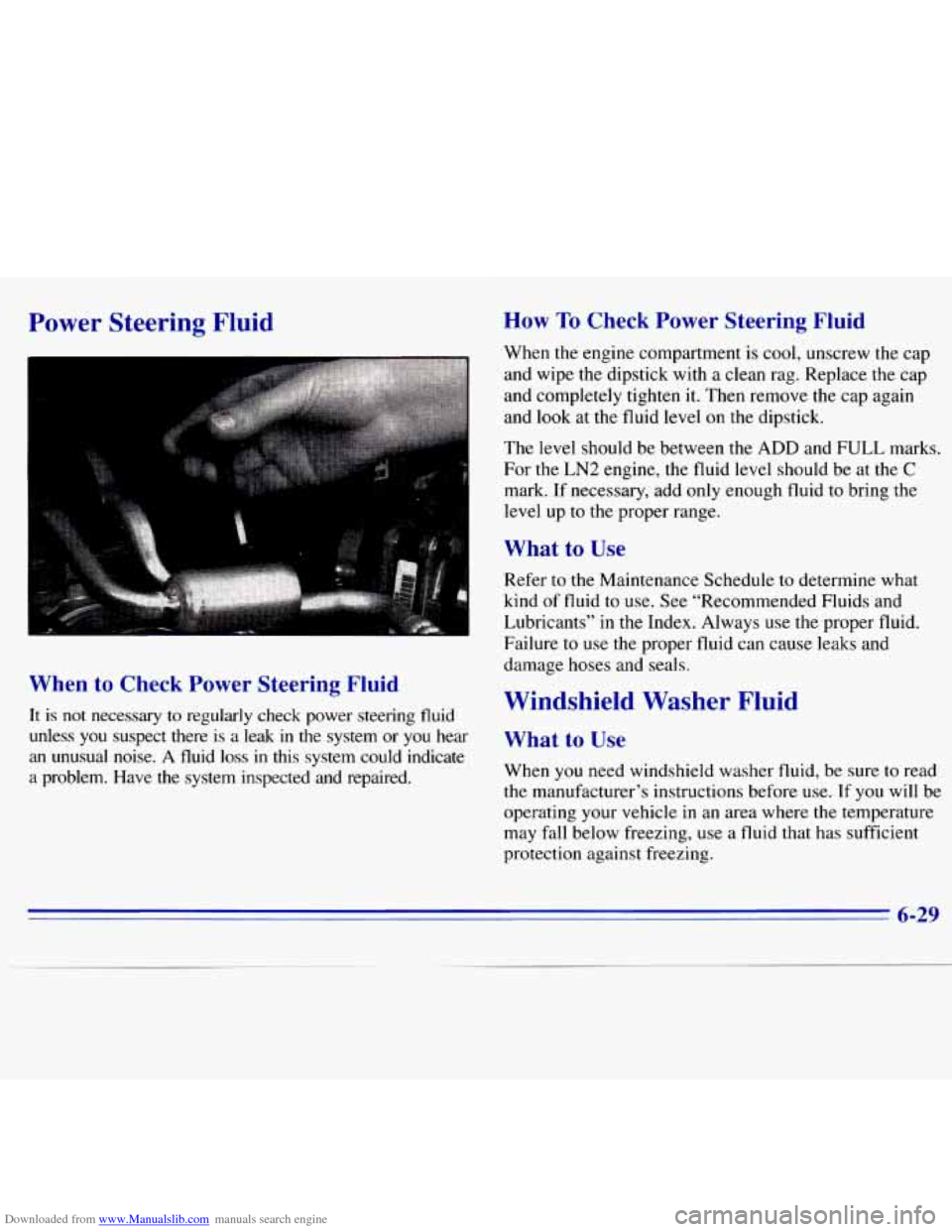
Downloaded from www.Manualslib.com manuals search engine Power Steering Fluid How To Check Power Steering Fluid
When the engine compartment is cool, unscrew the cap
and wipe the dipstick with a clean rag. Replace the cap
and completely tighten it. Then remove the cap again
and
look at the fluid level on the dipstick.
The level should be between the
ADD and FULL marks.
For the
LN2 engine, the fluid level should be at the C
mark. If necessary, add only enough fluid to bring the
level up
to the proper range.
What to Use
Refer to the Maintenance Schedule to determine what
kind of fluid
to use. See “Recommended Fluids and
Lubricants” in the Index. Always use the proper fluid.
Failure to
use the proper fluid can cause leaks and
damage hoses and seals.
Windshield Washer Fluid
What to Use
When you need windshield washer fluid, be sure to read
the manufacturer’s instructions before use. If you will be
operating your vehicle
in an area where the temperature
may fall below freezing, use a fluid that has sufficient
protection against freezing.
When to Check Power Steering Fluid
It is not necessary to regularly check power steering fluid
unless you suspect there is a leak
in the system or you hear
an unusual noise.
A fluid loss in this system could indicate
a problem. Have
the system inspected and repaired.
6-29
Page 347 of 375

Downloaded from www.Manualslib.com manuals search engine Part C: Periodic Maintenance
Inspections
Listed below are inspections and services which should
be perfowed at least twice a year (for instance, each
spring and fall). You should let your GM dealer’s
service department or other qualified service center do
these
jobs. Make sure any necessary repairs are
completed at once.
Proper procedures to perform these services may be
found in a service manual. See “Service and Owner
Publications’’ in the Index.
Steering and Suspension Inspection
Inspect the front and rear suspension and steering
system for damaged, loose or missing parts, signs of
wear or lack of lubrication. Inspect the power steering
lines and hoses for proper hook-up, binding, leaks,
cracks, chafing, etc.
Exhaust System Inspection
Inspect the complete exhaust system. Inspect the body near
the exhaust system. Look for broken, damaged, missing or
out-of-position parts
as well as open seams, holes, loose
connections or other conditions which could cause a heat
build-up in the floor pan or could let exhaust fumes into
the vehicle. See “Engine Exhaust” in the Index.
Radiator and Heater Hose Inspection
Inspect the hoses and have them replaced if they are
cracked, swollen or deteriorated; Inspect all pipes,
fittings and clamps; replace as needed.
Throttle Linkage Inspection
Inspect the throttle linkage for interference or binding,
and for damage or missing parts. Replace parts as
needed. Replace any cables that have high effort or
excessive wear.
Do not lubricate accelerator and cruise
control cables.
7-51
Page 349 of 375
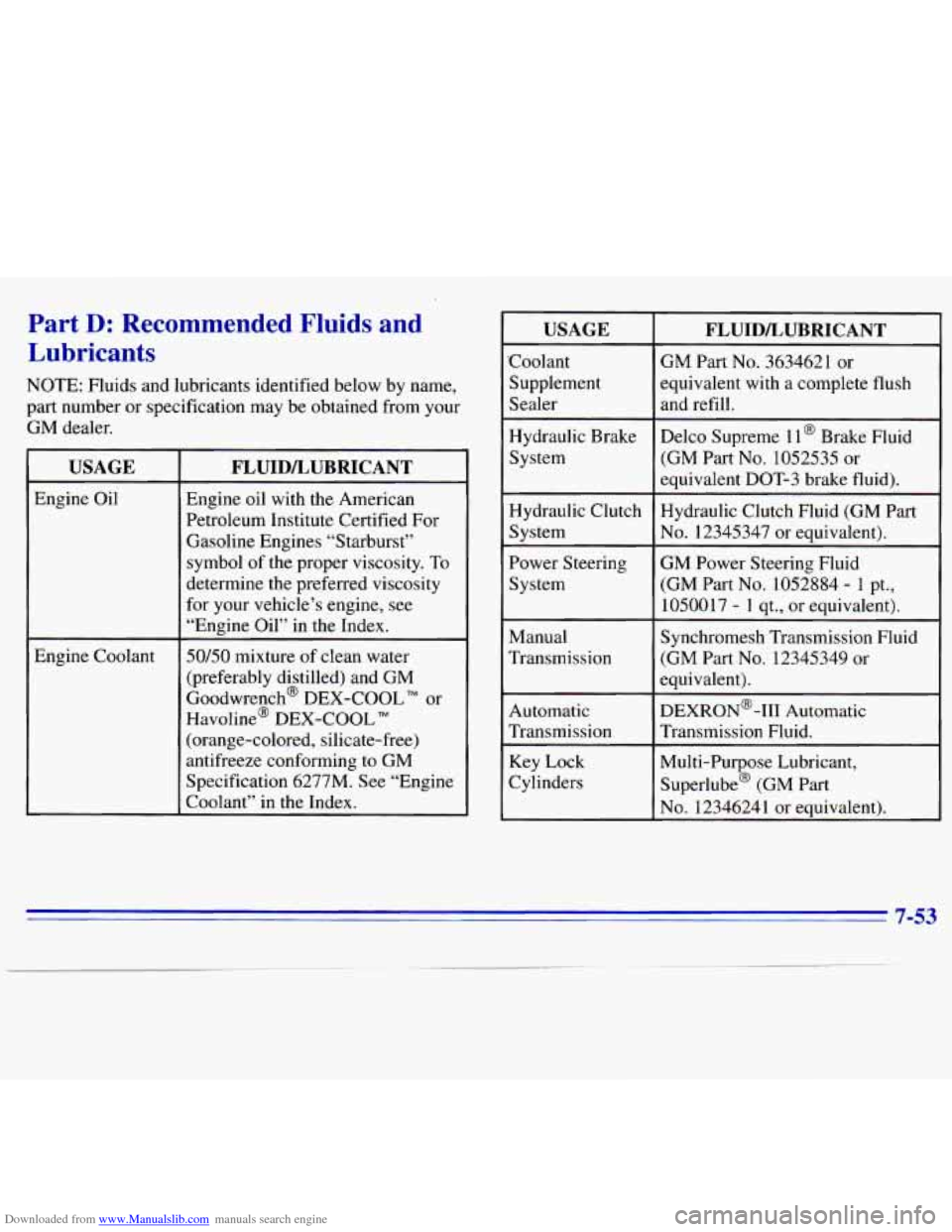
Downloaded from www.Manualslib.com manuals search engine Part D: Recommended Fluids and
Lubricants
NOTE: Fluids and lubricants identified below by name,
part number or specification
may be obtained from your
GM dealer.
USAGE
Engine Oil
Engine Coolant
FLUID/LUBRICANT
Engine oil with the American
Petroleum Institute Certified For
Gasoline Engines “Starburst”
symbol
of the proper viscosity. To
determine the preferred viscosity
for your vehicle’s engine, see
“Engine Oil” in the Index.
50/50 mixture of clean water
(preferably distilled) and GM
Goodwrench@ DEX-COOL
TM or
Havoline’ DEX-COOL
5M
(orange-colored, silicate-free)
antifreeze conforming to GM
Specification 6277M. See “Engine
Coolant”
in the Index.
USAGE
‘,Coolant
Supplement
Sealer
Hydraulic Brake
System
Hydraulic Clutch System
Power Steering System
Manual
Transmission
Automatic
Transmission
Key Lock
Cylinders
FLUIDLUBRICANT
GM Part No. 3634621 or
equivalent with a complete flush
and refill.
Delco Supreme
11 @ Brake Fluid
(GM Part No. 1052535 or
equivalent
DOT-3 brake fluid).
Hydraulic Clutch Fluid (GM Part
No. 12345347 or equivalent).
GM Power Steering Fluid
(GM Part No. 1052884 - 1 pt.,
1050017 - 1 qt., or equivalent).
Synchromesh Transmission Fluid
(GM Part
No. 12345349 or
equivalent).
DEXRON@-111 Automatic
Transmission Fluid.
Multi-Purpose Lubricant,
Superlube@ (GM Part
No. 1234624 1 or equivalent).
7-53
Page 369 of 375

Downloaded from www.Manualslib.com manuals search engine Halogen Bulbs ................................ 6-35
Hazard Warning Flashers
.......................... 5- I
Headlamps .................................... 2-39
Bulb Replacement
............................ 6-36
HighLow Beam Changer
...................... 2-35
Wiring
..................................... 6-62
Headlamps
On Reminder ......................... 2-40
Hearing Impaired. Customer Assistance
.............. 8-3
Heater Controls ................................. 3- I
Heater/Air Conditioning Controls ................... 3-2
Highway Hypnosis
.............................. 4-35
Hill and Mountain Roads
......................... 4-35
Hitches. Trailer
................................. 4-5 1
Hood .......................................... 6-7
Horn
......................................... 2-33
Horsepower
................................... 6-66
Hydraulic Clutch
............................... 6-20
HighLow
Beam Changer
........................ 2-35
Hydroplaning
.................................. 4-31
Ignition Positions
............................... 2-8
Inflation. Tire
.................................. 6-45
Inside Day/Night Rearview Mirror
................. 2-43
Inspections Brakesystem
................................ 7-52
Drive
Axle .................................. 7-52
Exhaust Systems
............................. 7-5 1
Radiator and Heater Hose ...................... 7-5 1
Steering .................................... 7-51 Suspension
.................................. 7-51
Throttle
Linkage ..............................
Instrument Panel ............................... 2-48
Cleaning
.................................... 6-55
Cluster ..................................... 2-50
Fuse Block .................................. 6-63
Interior Lamps
................................. 2-42
.................................... J ack. Tire 5-22
JumpSeat
...................................... 1-6
Jump Starting
................................... 5-2
Key
in the Ignition .............................. 2-7
Keyless Entry System
............................ 2-5
Key Lock Cylinders Service
...................... 7-48
Key Release Button
............................. 2-10
Keys
.......................................... 2-1
Labels CertificationRire
............................. 4-42
Fuse
....................................... 6-64
Safety Belt
.................................. 1-39
Service Parts Identification
..................... 6-61
Vehicle Identification Number
................... 6-61
Dome ...................................... 2-42
Front Map
................................... 2-42
Interior
..................................... 2-42
Lamps
........................................ 2-39
9-5